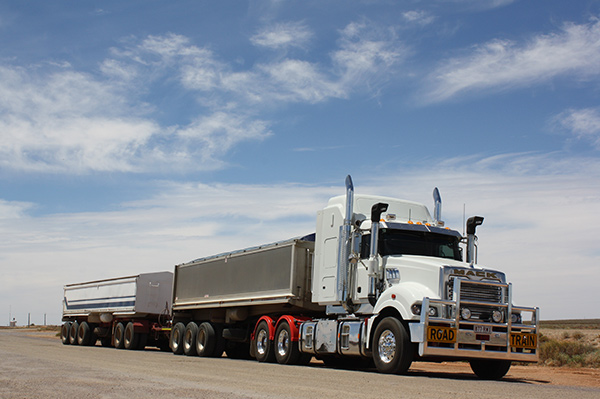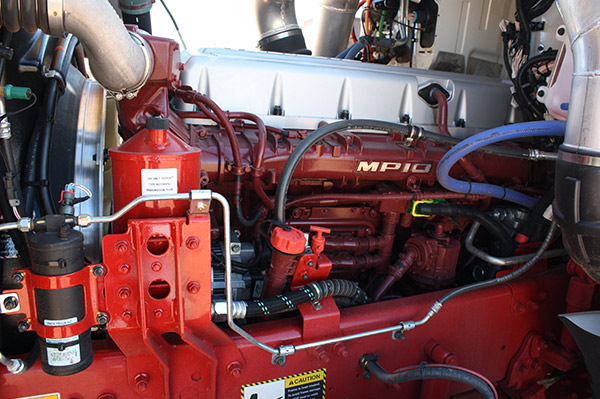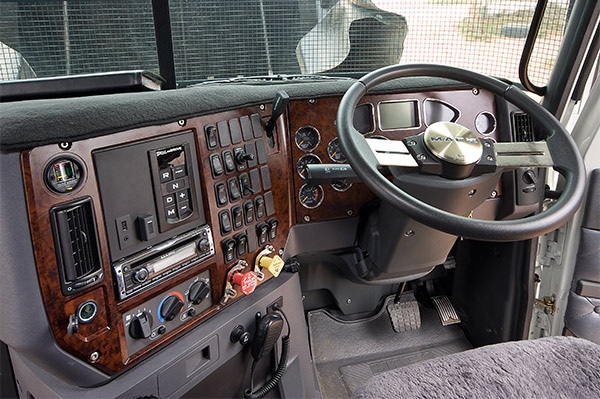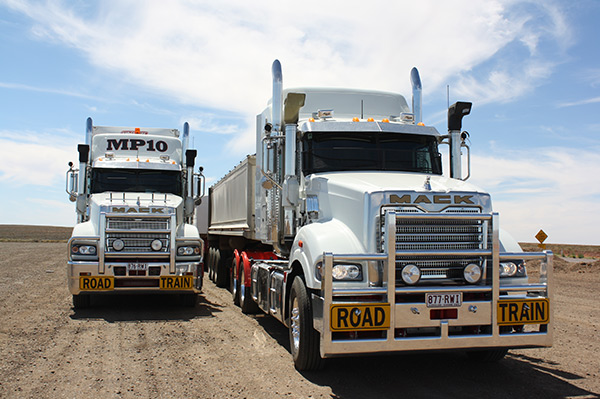To pull a heavy load, you need an engine with grunt, and driving a rig with pedigree like the Mack Trucks Titan 6x4 MP10 road train does no harm at all. Matt Wood reports.
The bullbar I’m leaning against belongs to a Mack Superliner, but even more importantly, behind the bullbar lurks Mack’s new 16-litre, 685hp MP10 engine, making the Superliner, and its heavier-duty sibling — the Titan — the most powerful on-road, conventional prime movers, currently available in this country.
A double road train combination is hanging off the back of the Superliner, with the whole rig grossing 80 tonnes. And, at this point in time, I’m waiting in a parking bay for the MP10-powered Titan, towing a 110-tonne triple road train, to arrive, giving me a chance to try out both of the big jiggers.
Mack’s heritage in this country is the stuff of legend. The ‘bulldog’ brand has been credited with playing a big part in revolutionising outback transport and heavy haulage, with its iconic B, and later, R model prime movers.
With the bulldog logo’s origins stemming from World War I, where British troops observed that the AC Mack had the tenacity of a bulldog, the bonnet emblem that first graced the front of a Mack truck back in 1932 has come to symbolise a part of Australia’s pioneering transport history.
Even now, you don’t have to look too far to find someone who’ll get misty-eyed about a Mack truck from “back in the day”.
But, a lot of water has trickled under the bridge since “back in the day”, and Mack’s rugged, bulldust-shrouded image has faded in the last couple of decades.
First, came Mack’s acquisition by Renault in the early ’90s, and then, a decade later, both were swallowed up by the Volvo group. There followed a couple of ill-fated, and perhaps underrated, Renault-sourced models (namely the “block of flats” Renault/Mack Magnum and the Quantum), both of which came and went without capturing the imagination of Australian operators.
All the while, Mack fans cried tears of blood over the departure of the mighty E-9 V8 engine. Those operators wanting to haul heavy loads into the back of beyond have, in many cases, moved on, with the Bulldog emblem now more often found coated in building site dust on the bonnet of a Metro Liner or Granite, than plastered with bug guts on a remote outback highway.
Mack, however, has been working hard to claw back some of its long and heavy haul kudos, and to shake ‘Volvo with a dog on the front’ perceptions.
A flourishing market for 26m B-double prime movers has seen a renewed zest for conventional prime movers, and the MP8-powered Trident has seen strong growth as a line-haul B-double contender, with some larger fleets willing to “let the dog out” and see how it performs.
Mack is now focusing on the high gross combination mass (GCM) end of the market and the source of its, once formidable, reputation as a back-blocks road train hauler.
With a GCM of up to 250 tonnes, and a myriad drive axle options (including both Mack and Sisu tri-drives), neither the Superliner nor the Titan are new to the multi-trailer roles.
To date, both have had to be content with either the Mack MP8 engine at 550hp (456kW) or Cummins Signature ‘motorvation’ for applications up to 620hp (456kW).
But now with the Australian release of the MP10, the dog is back, and it seems it’s finally got some teeth — as well as evading a trip to the vet for ‘the snip’. On top of that, the gold bulldog emblem makes a return with the option of an all-Mack drive train.
Engine
Available with either 600hp or 685hp (441kW/504kW) and 2,065ft-lb-2,300ft-lb (2,799Nm-3,118Nm) of torque, Mack seems to have an engine to crow about.
The MP10 has been seeing duty in the United States, at the lower horsepower rating, for a while now, and the basis of the power plant comes courtesy of Volvo’s 16-litre selective catalytic reduction (SCR) engine.
That being said, the MP10 has been developed for and by Mack at their Hagerstown facility in the US.
Transmission
At this stage, the 685hp version is only available with the M-drive 12-speed auto shift transmission (based on Volvo’s I-shift), though there is talk there will be a manual version at a later date.
But 600hp models can be specced-up, with Mack’s triple counter-shaft, 18-speed manual or Eaton’s 18-speed Road Ranger. The Cummins EGR ISX powerplant will still be an option up to 600hp.
Cab and Controls
One of the big advantages of the Titan and Superliner platforms is space, or more importantly, chassis space.
While the other big horsepower trucks on the market (namely Volvo’s FH16 700 and Scania’s R730) have prodigious horsepower ratings, they are hamstrung to a certain extent by their cabover configuration and lack of fuel-carrying capacity.
While this isn’t necessarily a big deal on B-double eastern seaboard work, it can become an issue off-the-beaten track.
The Titan, for example, can carry up to 1,950 litres of diesel and 150 litres of AdBlue, and the Superliner isn’t far behind with 1,650 litres of dinosaur juice, and the same AdBlue capacity as the Titan. This gives Mack a huge advantage as a long-haul and heavy-haulage prime mover.
The other plus for Mack is the availability of either a set forward or set back steer axle, to help juggle axle weights depending on application.
The cab interior, common to both the Titan and the Superliner, is a tasteful mix of vinyl tuck and hard plastic, with a wood grain-look dash and, in typical American fashion, more gauges than you can poke a stick at.
But digital technology still has its place. An understated LCD readout takes centre stage on the instrument panel between the tachometer and the speedo — the menu of which can be scrolled through using a steering column-mounted stalk.
My only real complaint would be the dash-mounted, windscreen-wiper control, which requires the driver to reach for the small switch, rather than have it at hand.
A basic, but well-trimmed and spacious, 52-inch (132cm) rise sleeper is mounted behind the cab, providing plenty of room to move.
The downsides of the Mack’s day-cab origins are, however, apparent. The raised lip, running across the floor of the cab where the back wall would once have been, is an annoyance, as is the lack of driver compartment head room when ducking into the sleeper.
This is compounded by a storage cubby hole, hanging from the centre of the cab roof. I suppose though, most of us tend to fall into the bunk rather than stroll into it after a big day anyway.
Performance
Morning light finds me at the wheel of the Superliner, on the northern outskirts of Port Augusta, and it’s time for me to see whether the new dog is more than just a Volvo wearing different clothes.
With the air gauges rapidly rising at idle, and all vital signs giving me the go-ahead, I hit the D button of the 12-speed M-drive transmission selector and slide out of the road train hook-up yard.
Once out on the open road, I bury the right foot, and the big 16-litre answers with a subdued bark, getting the double road train up to highway speed with ease.
At 80 tonnes, the rig feels surprisingly lively, and is relaxing to drive, as we head north towards the mining town of Roxby Downs.
Once we reach the bottom of the kilometre-long grade known as the Pimba ‘jump-up’, I back-off on my road speed to see how the drive train will perform on the long, demanding pull. With the gearbox still in economy mode, I put my foot down and let the 2,300lb-ft (3,118Nm) of torque do its thing.
The MP10 doesn’t let me down, dropping down to ninth gear and chugging to the top of the grade at 1,100rpm. The performance of the 80-tonne rig feels comparable to some B-double combinations I’ve driven, at gross weights in excess of
20 tonnes lighter than the Superliner is running at.
Pulling up at the Pimba roadhouse, I take the wheel of the Titan. As you would expect, the MP10 is now working a bit harder, dragging a triple-road train, grossing 110 tonnes, but gentle application of the throttle gets the combination rolling, as we continue to head north. In economy mode, engine revs are kept right in the peak torque range, between 1,000rpm and 1,500rpm.
By engaging the performance mode, the driver can change the shift patterns of the gear box and extend the time spent in any given gear by a couple of hundred rpm. That being said, the rig chugged along, quite happily, in economy mode.
With the mercury at 32C outside, the cooler-running characteristics of the SCR power plant come into play. The Titan’s temp gauge hovered between 85C and 90C, hitting 100C only on a grade, but the most impressive thing about the MP10’s cooling system was the engine fan; you can’t hear or feel it.
The electric over viscous fan coupling means that the fan gradually engages, as needed, without any of the horsepower-sucking roar common to many pneumatic-type engine fans on big horsepower donks.
Typically, a pneumatic engine fan will cut in on a climb, dragging on the engine just when you are looking for more pulling power — in many cases forcing the driver to grab a lower gear, in order to maintain both momentum and engine-cooling air flow. More fuel is burnt, as a consequence.
While the 1,757 square-inch (4,463 square-centimetre) radiator may not be the biggest in its class, the radiator’s aluminium construction means it tends to disperse heat quickly and efficiently.
The MP10 is equipped with Mack’s Powerleash engine brake which gives the beast 570hp at 2,200rpm. Descending the Pimba ‘jump up’ on the return journey gave me a chance to test the engine brake — and it certainly seemed up to the task — allowing me to hold the road train’s speed back, in conjunction with some strategically-placed stabs of the brake pedal.
On the road, both vehicles proved both stable and predictable in road train guise. The Superliner was equipped with parabolic, steer axle suspension, while the Titan was equipped with a Mack multi-leaf front end. Out of the two, my money was on the multi-leaf in terms of road manners.
Dolly-mounted combinations can be susceptible to trailer whip, if the steering wheel is thrown around too quickly. This is magnified when towing a triple, where a sharp yank on the tiller can easily send the rear trailer either off the road or into the oncoming lane.
The flared chassis rails of both prime movers mean that the one and a half tonne of engine iron out front is set lower in the chassis, between the rails.
The lower centre of gravity provided by the reduced height of the drive train made both prime movers easy to handle, even in the gusty crosswind which I encountered on the return leg, heading south back to Port Augusta.
Verdict
Without wanting to sound all Zen about it, both trucks had a great sense of ‘feel’ on the road. I felt isolated enough from engine and road noise to be comfortable, but not so much that I couldn’t feel the road or what the drive train was doing.
Road feel may not seem too important to someone hauling static loads on blacktop, but it grows in importance when you start talking about dragging six, wobbling decks of cattle through sand and scrub.
Also, I can confidently say that neither truck drove like any Volvo that I’ve driven to date. With 685 horses and 2,300 lb-ft of torque on tap and the option of a gold doggie out front, maybe Mack now have a flagship worthy of that old dust-shrouded legend.
Specifications
Make/Model: Mack Superliner 6×4
Engine: Mack 16.1-litre MP10 SCR (selective catalytic reduction).
Transmission: Mack M-Drive 12-speed auto shift.
Steer axle: Mack parabolic
Drive axle: Meritor 3.91 final drive
Fuel capacity: 1,650 litres diesel, 150 litres AdBlue
GCM: 130 tonnes
Make/Model: Mack Titan 6×4
Engine: Mack 16.1-litre MP10 SCR (selective catalytic reduction).
Transmission: Mack M-Drive 12-speed auto shift.
Steer axle: Mack Multi-leaf
Drive axle: Meritor 4.30 final drive
Fuel capacity: 1,950 litres Diesel, 150 litres AdBlue
GCM: 140 tonnes







